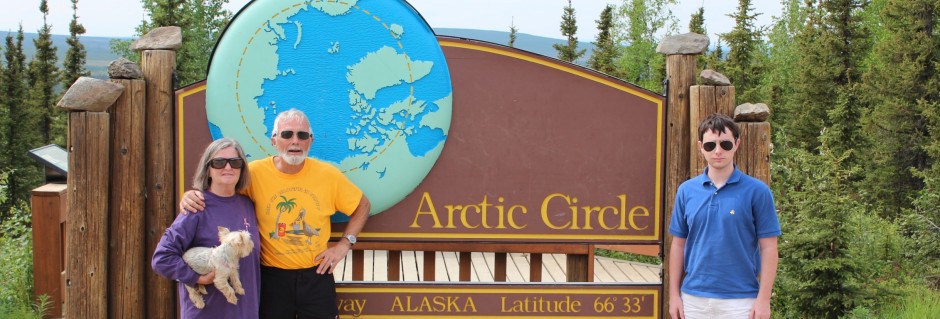Chuck:
Jim “Clutch” had said that he would whip up some blueberry pancakes for breakfast. As I walked over to his little cabin, I heard a loon calling. The air was crisp and clear, snow streaked mountains surrounded us, rusting metal relics of old mining equipment were scattered about in a loose display between the cabins. Jim has an unending supply of stories of this area, the North, mining, etc. Clutch is a big ‘Santa like’ guy, maybe in his seventies, long white beard and hair. As he was cooking and spinning a yarn about the largest gold nugget ever found in this area, his friend “Walt” appeared. Walt currently drives a tour bus and they often stop for the night at Wiseman. He is another fountain of knowledge concerning the history of Alaska and this area. These two ‘old timers’ could alternate telling stories of the North for hours, maybe days. I wished I had a tape recorder: a local guy went through the river ice with a bull dozer, another drove a tractor 40 miles to find shelter when his truck broke down in 50 below weather, an unplanned party that went on for days during a winter storm, etc, etc.
As we say good-bye to these guys, they continue uninterrupted by our departure. The road north climbs to Chandler Shelf, then on up to the pass that crosses the Brooks Range and heads down the North Slope. After crossing Atigun Pass, we saw about a dozen mountain sheep high on the side of a mountain. When we were crossing the tundra, about 50 miles south of Prudhoe, we started seeing caribou, mostly in small groups of 5 to 20. I was trying to keep a count but lost track after 200. There was one herd of musk-ox, maybe 30. Also, a large red fox was so busy eating a hare that it tolerated us being within 100 feet. We arrived in Deadhorse, a portion of the larger Prudhoe Bay area. It is a huge industrial camp. There are very few signs, we looked for the Deadhorse Camp Hotel. After checking several possibilities, Betty found the right one and made arrangements for another “Spartan” room and a cafeteria, all you can eat, meal. While Bren checked his messages (we have cell coverage and maybe Internet here), Betty & I found the unmanned gas pumps. The pump meters are in an outdoor cabinet and you step inside a small enclosure to swipe a card and start the pump. Before dispensing fuel, you place a 2’ x 3’ fabric tub (called the Rubber Duck) under the gas cap area to preclude any spillage. As we ate in the crew cafeteria, we met “Mike the Tour Guide”, he brings a van load of folks from Fairbanks to Prudhoe every week; probably much like Walt’s operation. Mike is very helpful and explains how we can best use our time here. Betty made arrangements for a half-day tour of the oil fields for the next morning. This central part and sort of headquarters for all oil field operations, is a busy, industrial complex with conex containers of all sizes everywhere, new heavy equipment lined up in rows, each company or contractor has an assigned area, this is a bee-hive of activity; reminds me of a military base camp. It has the basics: running water for showers & flush toilets, semi-permanent kitchen facilities, heat and small, two person, crew rooms. No frills, but mostly clean basics. There is melting ice everywhere which results in standing water and mud pretty much everywhere. The mess hall and dorms have disposable little blue booties to slip over your shoes or boots so the mud does not get tracked into living areas as much as it might otherwise. There are lots of birds here; we need Jean B. or Mary H. here to help with identification and also the migration story of each species. We see birds in nearly every bit of open water between slabs of melting ice: Long Tail Jeager, king eider (plus several other eiders), Canada geese, Pacific Loon, trumpeter swan, arctic tern, mallard & merganser ducks and bunches of others. Plus, those “naughty” gulls, which eat other birds’ eggs & chicks.
Betty: We had sketchy cell coverage and no internet. Once we got north of Fairbanks we rarely had TV, cell or internet. Every once in a while we’d accidentally be able to tap into something fleetingly. We found that in Canada and in Alaska when we have internet there is usually some control on it. We can only use it for an hour or we can only have a certain number of megabytes. That’s not a problem when writing something or checking messages but it really is a problem for trying to post pictures.
